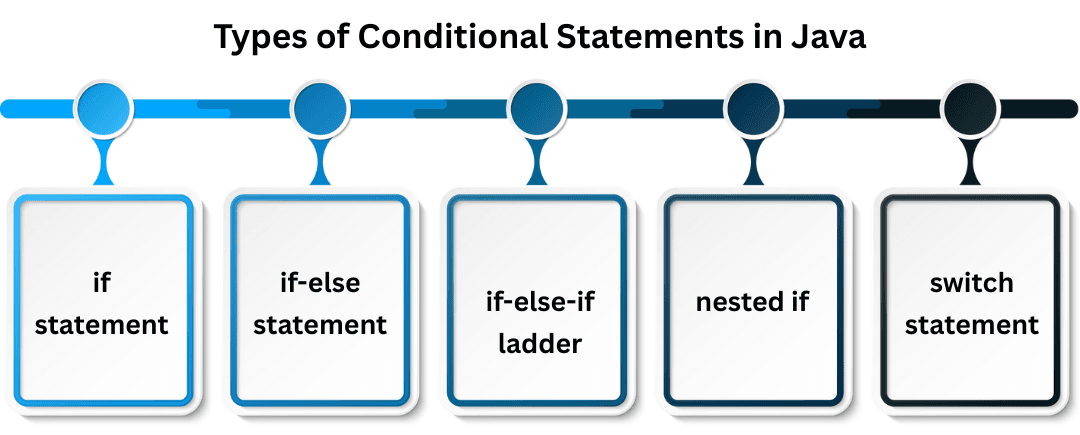Java Conditional Statements
Conditional statements are a key part of Core Java programming.
They help you make decisions in your code — executing different actions based on certain conditions.
What Are Conditional Statements?
Conditional statements allow your program to check conditions (like true or false) and decide which block of code to execute.
For example,
“If the user is above 18, print ‘Eligible to vote’, else print ‘Not eligible’.”
Types of Conditional Statements in Java

| Type | Description |
|---|---|
if statement | Executes a block only if condition is true |
if-else statement | Executes one block if true, another if false |
if-else-if ladder | Checks multiple conditions sequentially |
nested if | if inside another if |
switch statement | Selects one case from multiple options |
1. if Statement
The simplest conditional form — checks a condition and executes code if it’s true.
if (condition) {
// code to execute if condition is true
}
Example:
int age = 20;
if (age >= 18) {
System.out.println("You are eligible to vote.");
}
Output:
You are eligible to vote.
2. if-else Statement
Executes one block if the condition is true, another block if false.
if (condition) {
// code if true
} else {
// code if false
}
Example:
int number = 10;
if (number % 2 == 0) {
System.out.println("Even Number");
} else {
System.out.println("Odd Number");
}
Output:
Even Number
3. if-else-if Ladder
Used when you have multiple conditions to check.
if (condition1) {
// code
} else if (condition2) {
// code
} else {
// default code
}
Example:
int marks = 85;
if (marks >= 90) {
System.out.println("Grade A");
} else if (marks >= 75) {
System.out.println("Grade B");
} else if (marks >= 50) {
System.out.println("Grade C");
} else {
System.out.println("Fail");
}
Output:
Grade B
4. Nested if Statement
You can use one if statement inside another.
It’s useful when multiple conditions depend on each other.
Example:
int age = 25;
boolean hasID = true;
if (age >= 18) {
if (hasID) {
System.out.println("Access Granted");
} else {
System.out.println("ID Required");
}
} else {
System.out.println("Underage");
}
Output:
Access Granted
5. switch Statement
switch is used to select one option from many.
It’s more readable than multiple if-else blocks.
Syntax:
switch (expression) {
case value1:
// code
break;
case value2:
// code
break;
default:
// code
}
Example:
int day = 3;
switch (day) {
case 1:
System.out.println("Monday");
break;
case 2:
System.out.println("Tuesday");
break;
case 3:
System.out.println("Wednesday");
break;
default:
System.out.println("Invalid day");
}
Output:
Wednesday
Java 14+ Enhancement – Switch Expressions
Modern Java allows switch as an expression, returning a value directly.
Example:
int day = 2;
String dayName = switch (day) {
case 1 -> "Monday";
case 2 -> "Tuesday";
case 3 -> "Wednesday";
default -> "Invalid";
};
System.out.println(dayName);
Output:
Tuesday
Example: Conditional Statements in Action
import java.util.Scanner;
public class ConditionalExample {
public static void main(String[] args) {
Scanner sc = new Scanner(System.in);
System.out.print("Enter your score: ");
int score = sc.nextInt();
if (score >= 90) {
System.out.println("Excellent!");
} else if (score >= 75) {
System.out.println("Good job!");
} else if (score >= 50) {
System.out.println("You passed!");
} else {
System.out.println("Try again!");
}
sc.close();
}
}
Output Example:
Enter your score: 82
Good job!
🏆 Top 5 Java Interview Questions - Java Conditional Statements
1. What is the difference between if and switch?
Answer:
| Feature | if Statement | switch Statement |
|---|---|---|
| Usage | Evaluates boolean expressions | Evaluates a single expression/value |
| Type of Conditions | Complex conditions with relational/logical operators | Single variable/value with multiple discrete cases |
| Data Types | Any boolean expression | int, byte, short, char, String (Java 7+), enums |
| Syntax | Can be multiple if-else if-else | case statements with optional default |
| Performance | Slightly slower for multiple discrete values | Faster for large number of discrete values |
2. Can we use String in switch statement?
Answer:
- Yes, starting from Java 7,
Stringcan be used in aswitchstatement. - Example:
String fruit = "Apple";
switch(fruit) {
case "Apple": System.out.println("Red"); break;
case "Banana": System.out.println("Yellow"); break;
default: System.out.println("Unknown");
}
3. What happens if we forget to use break in a switch?
Answer:
- If
breakis omitted, control falls through to the next case(s) until a break or the end of the switch. - Example:
int day = 2;
switch(day) {
case 1: System.out.println("Monday");
case 2: System.out.println("Tuesday");
case 3: System.out.println("Wednesday");
}
Output:
Tuesday
Wednesday
This is called fall-through behavior.
4. What is a nested if statement?
Answer:
- A nested if statement is an
iforif-elseblock inside another if or else block. - Example:
int num = 10;
if(num > 0) {
if(num % 2 == 0) {
System.out.println("Positive even number");
}
}
5. What are switch expressions introduced in Java 14?
Answer:
- Switch expressions allow the
switchto return a value, not just execute statements. - They use
>syntax and do not requirebreak. - Example:
int day = 3;
String dayName = switch(day) {
case 1 -> "Monday";
case 2 -> "Tuesday";
case 3 -> "Wednesday";
default -> "Unknown";
};
System.out.println(dayName); // Output: Wednesday
Benefits: More concise, avoids fall-through errors, can directly assign the result to a variable.

